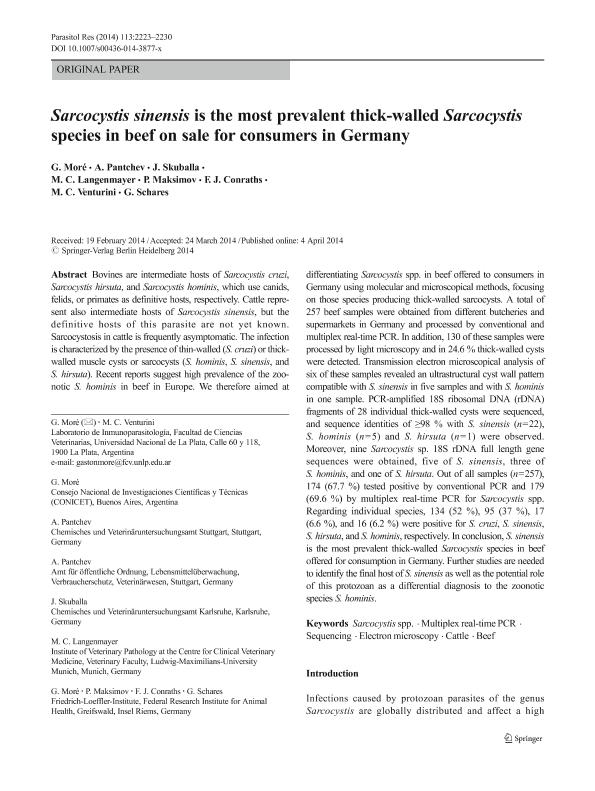Mostrar el registro sencillo del ítem
dc.contributor.author
Moré, Gastón Andrés

dc.contributor.author
Pantchev, A
dc.contributor.author
Skuballa, J
dc.contributor.author
Langenmayer, M.C.
dc.contributor.author
Maksimov, P
dc.contributor.author
Conraths, F.J.
dc.contributor.author
Venturini, María Cecilia

dc.contributor.author
Schares, G.
dc.date.available
2018-01-09T17:32:11Z
dc.date.issued
2014-06
dc.identifier.citation
Schares, G.; Venturini, María Cecilia; Conraths, F.J.; Maksimov, P; Skuballa, J; Pantchev, A; et al.; Sarcocystis sinensis is the most prevalent thick-walled Sarcocystis species in beef on sale for consumers in Germany; Springer; Parasitology Research; 113; 6; 6-2014; 2223-2230
dc.identifier.issn
0932-0113
dc.identifier.uri
http://hdl.handle.net/11336/32671
dc.description.abstract
Bovines are intermediate hosts of Sarcocystis cruzi, Sarcocystis hirsuta, and Sarcocystis hominis, which use canids, felids, or primates as definitive hosts, respectively. Cattle represent also intermediate hosts of Sarcocystis sinensis, but the definitive hosts of this parasite are not yet known. Sarcocystosis in cattle is frequently asymptomatic. The infection is characterized by the presence of thin-walled (S. cruzi) or thick-walled muscle cysts or sarcocysts (S. hominis, S. sinensis, and S. hirsuta). Recent reports suggest high prevalence of the zoonotic S. hominis in beef in Europe. We therefore aimed at differentiating Sarcocystis spp. in beef offered to consumers in Germany using molecular and microscopical methods, focusing on those species producing thick-walled sarcocysts. A total of 257 beef samples were obtained from different butcheries and supermarkets in Germany and processed by conventional and multiplex real-time PCR. In addition, 130 of these samples were processed by light microscopy and in 24.6 % thick-walled cysts were detected. Transmission electron microscopical analysis of six of these samples revealed an ultrastructural cyst wall pattern compatible with S. sinensis in five samples and with S. hominis in one sample. PCR-amplified 18S ribosomal DNA (rDNA) fragments of 28 individual thick-walled cysts were sequenced, and sequence identities of ≥98 % with S. sinensis (n = 22), S. hominis (n = 5) and S. hirsuta (n = 1) were observed. Moreover, nine Sarcocystis sp. 18S rDNA full length gene sequences were obtained, five of S. sinensis, three of S. hominis, and one of S. hirsuta. Out of all samples (n = 257), 174 (67.7 %) tested positive by conventional PCR and 179 (69.6 %) by multiplex real-time PCR for Sarcocystis spp. Regarding individual species, 134 (52 %), 95 (37 %), 17 (6.6 %), and 16 (6.2 %) were positive for S. cruzi, S. sinensis, S. hirsuta, and S. hominis, respectively. In conclusion, S. sinensis is the most prevalent thick-walled Sarcocystis species in beef offered for consumption in Germany. Further studies are needed to identify the final host of S. sinensis as well as the potential role of this protozoan as a differential diagnosis to the zoonotic species S. hominis.
dc.format
application/pdf
dc.language.iso
eng
dc.publisher
Springer

dc.rights
info:eu-repo/semantics/openAccess
dc.rights.uri
https://creativecommons.org/licenses/by-nc-sa/2.5/ar/
dc.subject
Sarcocystis Spp.
dc.subject
Multiplex Real-Time Pcr
dc.subject
Sequencing
dc.subject
Electron Microscopy
dc.subject
Cattle
dc.subject
Beef
dc.subject.classification
Otras Ciencias Veterinarias

dc.subject.classification
Ciencias Veterinarias

dc.subject.classification
CIENCIAS AGRÍCOLAS

dc.title
Sarcocystis sinensis is the most prevalent thick-walled Sarcocystis species in beef on sale for consumers in Germany
dc.type
info:eu-repo/semantics/article
dc.type
info:ar-repo/semantics/artículo
dc.type
info:eu-repo/semantics/publishedVersion
dc.date.updated
2018-01-08T18:57:00Z
dc.journal.volume
113
dc.journal.number
6
dc.journal.pagination
2223-2230
dc.journal.pais
Alemania

dc.journal.ciudad
Berlin
dc.description.fil
Fil: Moré, Gastón Andrés. Consejo Nacional de Investigaciones Científicas y Técnicas; Argentina. Universidad Nacional de la Plata. Facultad de Ciencias Veterinarias. Departamento de Epizootiología y Salud Pública. Laboratorio de Inmunoparasitología; Argentina
dc.description.fil
Fil: Pantchev, A. Chemisches und Veterinäruntersuchungsamt Stuttgart. Stuttgart; Alemania. Veterinärwesen. Stuttgart; Alemania
dc.description.fil
Fil: Skuballa, J. Chemisches und Veterinäruntersuchungsamt Karlsruhe. Karlsruhe; Alemania
dc.description.fil
Fil: Langenmayer, M.C.. University Munich. Munich; Alemania
dc.description.fil
Fil: Maksimov, P. Insel Riems; Alemania
dc.description.fil
Fil: Conraths, F.J.. Insel Riems; Alemania
dc.description.fil
Fil: Venturini, María Cecilia. Universidad Nacional de la Plata. Facultad de Ciencias Veterinarias. Departamento de Epizootiología y Salud Pública. Laboratorio de Inmunoparasitología; Argentina
dc.description.fil
Fil: Schares, G.. Insel Riems; Alemania
dc.journal.title
Parasitology Research

dc.relation.alternativeid
info:eu-repo/semantics/altIdentifier/doi/http://dx.doi.org/10.1007/s00436-014-3877-x
dc.relation.alternativeid
info:eu-repo/semantics/altIdentifier/url/https://link.springer.com/article/10.1007%2Fs00436-014-3877-x
Archivos asociados
